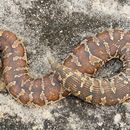en
names in breadcrumbs


ભંફોડી કે દરઘોઈ કે દરગોઈ કે ધુણી ( અંગ્રેજી: Common Sand Boa, Russell’s Earth Boa દ્વિપદ-નામ:Eryx conicus) એ ગુજરાતમાં દેખાતી સર્પોના કુલ બાર(૧૨) કુટુંબોની ત્રેસઠ[૧] (૬૩) જાતિઓમાંની એક બિનઝેરી સર્પની જાતી છે.
ખાસ સૂચના: આ બિનઝેરી સર્પ અને ખુબ ઝેરી સર્પ ખડચિતળો વચ્ચે દેખાવમાં સામ્યતા છે. ઓળખમાં ગફતલ જીવલેણ બની શકે છે[૨].
આ સર્પના આખા શરીરનો રંગ ઝાંખો બદામી ઝાંખો ભૂખરો હોય છે જે એકમેક સાથે સંકળાયેલા પીળી કે સફેદ કિનારીવાળા અનિયમિત આકાર અને કદના ઘેરા બદામી ધબ્બાઓથી છવાયેલું હોય છે. પેટનો ભાગ લીલાશ પડતો સફેદ હોય છે. ટૂંકી અને અન્ય સર્પોના પ્રમાણમાં અણીદાર પુછડી હોય છે. મુખ્યત્વે નિશાચર આ સર્પને સુકુ હવામાન જ અને ખાસ કરીને રેતાળ પ્રદેશો માફક આવે છે કે જ્યાં તે નરમ રેતીમાં અંદર ઉપરીને શીકારની રાહ જોઇ શકે. સામાન્ય પણે બે ફીટ લંબાઈનો જોવા મળે છે અને મહત્તમ લંબાઈ બે ફીટ છ ઈંચ જોવા મળી છે.
આ સર્પને ભોજન તરીકે ખિસકોલી, ઉંદર, દેડકા વગેરે હોય છે[૩].
એક પ્રજનન ગાળામાં ૬ થી ૮ બચ્ચાને જન્મ આપે છે[૩].
ભંફોડી કે દરઘોઈ કે દરગોઈ કે ધુણી ( અંગ્રેજી: Common Sand Boa, Russell’s Earth Boa દ્વિપદ-નામ:Eryx conicus) એ ગુજરાતમાં દેખાતી સર્પોના કુલ બાર(૧૨) કુટુંબોની ત્રેસઠ (૬૩) જાતિઓમાંની એક બિનઝેરી સર્પની જાતી છે.
அயகரம்[2] (Gongylophis conicus) என்பது ஒரு நச்சுத் தன்மையற்ற பாம்பு. இது தன் இரையை நெரித்துக்கொன்று பின்னர் உட்கொள்ளும் என்பதால் இது ஒரு மலைப்பாம்பு வகையாகும். இதை மண் மலைப்பாம்பு என்றும், சிறிய மலைப்பாம்பு என்றும், மணியன் என்றும் அழைப்பர்.
தொந்தரவு தரப்பட்டால், உடலை உப்பச்செய்து விரியன் பாம்புகளைப் போல் இவை கொத்தும். ஆனால் இவற்றிற்கு நஞ்சு இல்லாததால் மாந்தருக்கும் பிற பெரிய விலங்குகளுக்கும் உயிரிழக்கும் வாய்ப்பு இல்லை.
Snakes of India - The Field Guide -- இரோமுலசு விட்டேக்கர் மற்றும் அசோக் கேப்டன்
அயகரம் (Gongylophis conicus) என்பது ஒரு நச்சுத் தன்மையற்ற பாம்பு. இது தன் இரையை நெரித்துக்கொன்று பின்னர் உட்கொள்ளும் என்பதால் இது ஒரு மலைப்பாம்பு வகையாகும். இதை மண் மலைப்பாம்பு என்றும், சிறிய மலைப்பாம்பு என்றும், மணியன் என்றும் அழைப்பர்.
Eryx conicus, also known as Russell's boa, the rough-scaled sand boa or the rough-tailed sand boa, is a species of non-venomous snake in the subfamily Erycinae of the family Boidae. The species is native to Southern Asia. No subspecies are recognised.[4]
Adults of G. conicus may attain a total length of 3 feet 3 inches (99 cm), which includes a tail 3 inches (76 mm) long.
The anterior maxillary and mandibular teeth are longer than the posterior. The head is covered with small scales. The eye is small with a vertical pupil. The dorsal scales are small and keeled. The tail is pointed, not or but very slightly prehensile.[5]
The rostral scale is twice as broad as long, slightly prominent, without an angular horizontal edge. The top of the head is covered with small obtusely keeled scales, except for the nasals and internasals which are enlarged. Interorbitals: 8 to 10. Circumorbitals: 10 to 15. The eye is separated from the labials by one or two rows of scales. Supralabial scales: 12 to 14. Dorsal scales tubercularly keeled, in 40 to 49 rows. Ventral scales: 162-186. The anal scale is single. Subcaudals: 17-24.[5]
The anterior dorsal scales are only feebly keeled, but these keels increase in size posteriorly to the point that they become so heavily keeled that it can make a squirming specimen really painful to handle. This also makes it look as if the front and rear ends belong to markedly different animals.[6]
Dorsally, the color pattern consists of a broad zigzag band or a series of dark brown blotches on a yellowish or brownish grey ground color. The belly is uniform white.[5]
In India it can be mistaken at first glance for either the Indian python (Python molurus) or the deadly Russell's viper (Daboia russelii).
E. conicus is active at dusk and at night.[7]
E. conicus preys upon birds and small mammals, which it kills by constricting.[7]
E. conicus is found in India south of about 30°N latitude, Nepal, Bangladesh and in the northern arid region of Sri Lanka. The type locality given is "India orientali ".[2]
The preferred habitat of E. conicus is sandy tracts of central and southern India, the Punjab, Kachchh, and Sind.
The rough-scaled sand boa's color pattern frequently resembles that of the highly venomous Russell's viper, which some herpetologists believe is a case of Batesian mimicry.[8]
E. conicus is viviparous.[9]
Eryx conicus, also known as Russell's boa, the rough-scaled sand boa or the rough-tailed sand boa, is a species of non-venomous snake in the subfamily Erycinae of the family Boidae. The species is native to Southern Asia. No subspecies are recognised.
Eryx conicus Eryx generoko animalia da. Narrastien barruko Scincidae familian sailkatuta dago.
Eryx conicus Eryx generoko animalia da. Narrastien barruko Scincidae familian sailkatuta dago.
Eryx conicus est une espèce de serpents de la famille des Boidae[1].
Cette espèce se rencontre au Pakistan, au Népal, en Inde et au Sri Lanka[1].
Ces serpents mesurent jusqu'à un mètre.
Selon Reptarium Reptile Database (14 février 2014)[2] :
Gongylophis conicus là một loài rắn trong họ Boidae. Loài này được Schneider mô tả khoa học đầu tiên năm 1801.[2]
Gongylophis conicus là một loài rắn trong họ Boidae. Loài này được Schneider mô tả khoa học đầu tiên năm 1801.